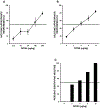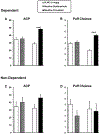Acute nicotine reinforcement requires ability to discriminate the stimulus effects of nicotine
- PMID: 33119384
- PMCID: PMC8406437
- DOI: 10.1037/pha0000433
Acute nicotine reinforcement requires ability to discriminate the stimulus effects of nicotine
Abstract
This review of research on behavioral discrimination of nicotine and how it informs public health policy for reducing risk of tobacco dependence is adapted from Kenneth A. Perkins's American Psychological Association Division 28 (Psychopharmacology and Substance Abuse) 2020 Med Associates Brady/Schuster Award Lecture. The author's initial programmatic clinical research on nicotine is introduced, especially efforts to develop and validate a novel method of acute nicotine dosing. After the public health rationale for characterizing the discriminative stimulus effects of nicotine in humans are described, details from two separate programs of research on nicotine discrimination in humans are presented. The first, conducted with nicotine dosing by nasal spray, documented that humans could discriminate nicotine administered rapidly, examined nicotine's neuropharmacological specificity, identified discrimination threshold dose in smokers and nonsmokers, and explored other conditions that might alter ability to discriminate its effects. The second, more recent program focused on threshold doses for discrimination of nicotine by cigarette smoking, a program that was very difficult to do until the past decade, and how nicotine's self-reported "reward" and preference via choice behavior relate to its discriminability. Differences due to menthol and degree of tobacco dependence were also examined. For each of these two programs, the main findings of selected studies are noted, followed by very recent work on nicotine discrimination and choice that informs Food and Drug Administration's efforts to formulate public policy to improve health and reduce the nearly half million American deaths per year due to persistent tobacco use. (PsycInfo Database Record (c) 2022 APA, all rights reserved).
Conflict of interest statement
The author states no conflicts of interest are apparent in this review paper.
Figures



Similar articles
-
Preclinical and clinical research on the discriminative stimulus effects of nicotine.Neuropharmacology. 2020 Jun 15;170:108063. doi: 10.1016/j.neuropharm.2020.108063. Epub 2020 Mar 24. Neuropharmacology. 2020. PMID: 32220607 Review.
-
Threshold dose for behavioral discrimination of cigarette nicotine content in menthol vs. non-menthol smokers.Psychopharmacology (Berl). 2017 Apr;234(8):1255-1265. doi: 10.1007/s00213-017-4563-3. Epub 2017 Feb 16. Psychopharmacology (Berl). 2017. PMID: 28210778
-
Discriminative stimulus effects of nicotine in humans.Handb Exp Pharmacol. 2009;(192):369-400. doi: 10.1007/978-3-540-69248-5_13. Handb Exp Pharmacol. 2009. PMID: 19184656 Review.
-
The influence of alcohol pre-treatment on the discriminative stimulus, subjective, and relative reinforcing effects of nicotine.Behav Pharmacol. 2005 Nov;16(7):521-9. doi: 10.1097/01.fbp.0000175255.55774.19. Behav Pharmacol. 2005. PMID: 16170229 Clinical Trial.
-
The influence of caffeine on nicotine's discriminative stimulus, subjective, and reinforcing effects.Exp Clin Psychopharmacol. 2005 Nov;13(4):275-81. doi: 10.1037/1064-1297.13.4.275. Exp Clin Psychopharmacol. 2005. PMID: 16366757 Clinical Trial.
Cited by
-
The role of β-Nicotyrine in E-Cigarette abuse liability I: Drug Discrimination.bioRxiv [Preprint]. 2024 Jul 16:2024.07.12.603310. doi: 10.1101/2024.07.12.603310. bioRxiv. 2024. PMID: 39071347 Free PMC article. Preprint.
-
Society for Research on Nicotine and Tobacco as an Outgrowth of the 1988 Surgeon General's Report on Nicotine Addiction: Reflections of the Early Presidents.Nicotine Tob Res. 2024 Jan 22;26(2):118-125. doi: 10.1093/ntr/ntad151. Nicotine Tob Res. 2024. PMID: 37584666 Free PMC article. Review.
-
Pulsed nicotine infusions as a model for smoking: validating a tool to explore nicotine thresholds in humans.Psychopharmacology (Berl). 2024 Sep;241(9):1915-1922. doi: 10.1007/s00213-024-06609-6. Epub 2024 Jul 6. Psychopharmacology (Berl). 2024. PMID: 38970644
References
-
- Apelberg BJ, Feirman SP, Salazar E, et al. (2018). Potential public health effects of reducing nicotine levels in cigarettes in the United States. New England Journal of Medicine, 378(18), 1725–1733. - PubMed
-
- Bigelow GE, & Preston KL (1989) Drug discrimination: Methods for drug characterization and classification. In Fischman MW & Mello NK (eds), Testing for Abuse Liability of Drugs in Humans. NIDA Research Monograph 92, USDHHS: Washington DC. - PubMed
Publication types
MeSH terms
Substances
Grants and funding
LinkOut - more resources
Full Text Sources
Miscellaneous

